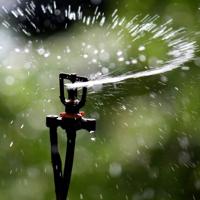‘Water-wise’ landscaping tips | Free News
Hood River County is currently out of drought status, but counties to the east and south continue to experience extreme-to-exceptional drought, according to the US Drought Monitor. Forecasters expect relatively warm and dry conditions across the central and eastern zones of the state this summer, and the region is looking at 100-plus degree temperatures for several days this week.
High temperatures and the persisting effects of drought can cause increased fire danger, stunted agricultural production, fishing closures for rivers, and toxic algae blooms in ponds and lakes. As we tap into irrigation at increasing rates (especially during hot weather stretches), our stream flows decrease and water temperatures increase. Instream and out-of-stream water supplies suffer. Low stream flows impair fish habitat, threaten aquatic life, and degrade water quality.
That all sounds pretty dire, but the good news is that everyone can help improve conditions for the farms, recreationalists, fish, and wildlife that make use of our priceless water resources. For many of us, the simplest place to conserve water is in our landscapes:
- Water early in the day between 4-9 am, when evaporation is lowest. The next best time is after 8 pm Avoid watering on windy days; wind increases evaporation.
- Water infrequently but deeply. This promotes growth of deep root systems so plants can withstand longer dry periods while staying healthy.
- Fix leaking or broken sprinklers, hoses, and water lines quickly.
- Never apply water faster than it can be absorbed. Sloped areas are tricky to water effectively. Contour around each plant to create a water well or use terracing.
- Use a broom instead of a hose to clean patios, sidewalks, and driveways.
- Redirect sprinklers to avoid hitting the pavement. The pavement doesn’t need watering.
- Replace high-flow sprinklers with low-flow, micro-sprinklers or drip irrigation lines.
- Remove weeds regularly and use a weed barrier such as mulch. Weeds rob other plants of water.
- Mix composted yard trimmings, manure, leaves, and other organics into your soil to increase water retention capacity and nutrients.
- Mulching with bark chips or weed-free straw can help decrease water loss from the soil. Mulch also keeps soil porous, improves aeration, and increases infiltration.
- If you have a water right and/or your water is delivered by an irrigation district or company, learn what your allotment is so that you can stay within it. If you do not have a water right, check with your domestic water provider to learn their rules for using domestic water for irrigation.
Typically, at least 50% of water consumed by households is used outdoors, and most of that is for lawns. Over-watering lawns leads to shallow root systems that are susceptible to drought, weeds, and disease. Too much irrigation also increases runoff that carries fertilizer and other pollutants into streams and groundwater. Most lawns only need about an inch of water a week to stay green. Use a can to measure how much your sprinklers apply.
For more information about conserving water on landscaping, visit www.hoodriverwatershed.org.


Comments are closed.